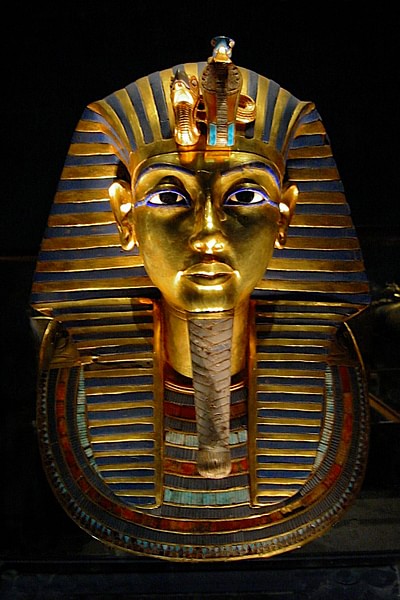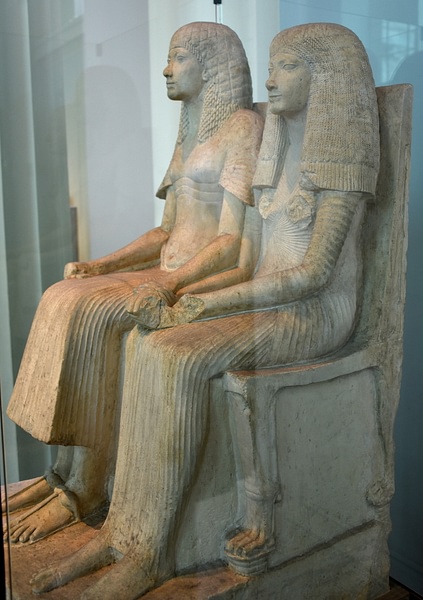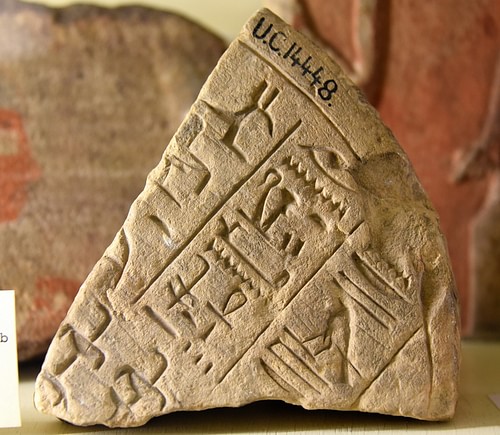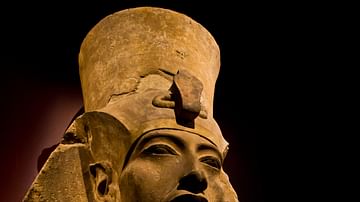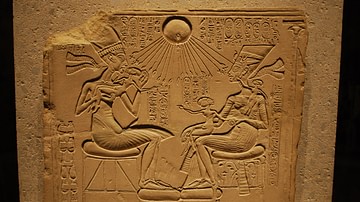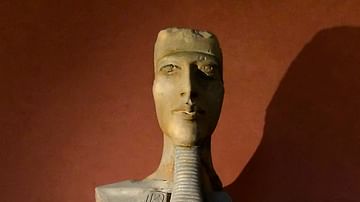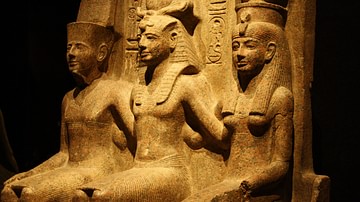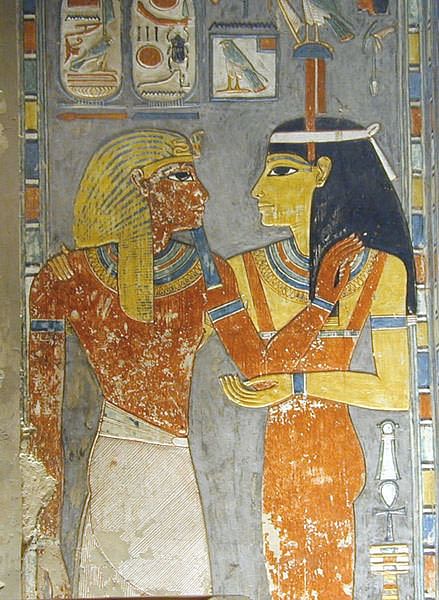
Horemheb (reigned 1320-1292 BCE) was the last pharaoh of the 18th dynasty of Egypt. He is also known as Dejserkheprure and Horemhab. His name means, “Horus is in Festival” and he came from the lower classes of Egypt, worked himself up through the ranks of the army, became commander-in-chief of the Egyptian military, and finally pharaoh.
Little is known about his early life, but it seems that he initially served under Amenhotep III and continued service under Akhenaten. He first comes to the notice of historians during the reign of Tutankhamun when he acted in the capacity of advisor to the young king along with the vizier Ay.
Ay succeeded Tutankhamun and, on his death, Horemheb took the throne, at which point he initiated a nation-wide campaign to erase his immediate predecessor's names from history and revitalize the nation that had declined under Akhenaten's rule. He is generally considered a good pharaoh, but whether he is a hero or villain depends upon one's view of Akhenaten's reign and Horemheb's reaction to it.
Early Career
Based upon his coronation text, Horemheb came from the city of Herakleopolis, but nothing is known of his parentage nor anything of his youth. He first appears in the historical record serving under Amenhotep III but, as this reference is unclear, he could have begun his career under Akhenaten. It would seem, however, that since he was quickly promoted by Akhenaten to Great Commander of the Army, he would have provided service to the throne earlier.
Akhenaten initiated religious reforms that proscribed the traditional polytheistic religious practices in Egypt and instituted monotheism in the form of the religion of Aten. Aten had been a minor sun deity prior to Akhenaten's reign but now became the supreme god of the universe and the only god the Egyptians were allowed to worship.
Further, Akhenaten proclaimed himself the incarnation of Aten and elevated his wife, Nefertiti, to equally divine status. Thus, the royal couple were not only the intermediaries between the people of Egypt and their god, they were the god incarnate. Whatever Horemheb may have thought of these reforms at the time is unknown but, based upon his later reaction to them, he did not approve. There would have been good reason for his displeasure. The historian Barbara Watterson notes that:
By the ninth year of his reign, Akhenaten had proscribed the old gods of Egypt, and ordered their temples to be closed, a very serious matter, for these institutions played an important part in the economic and social life of the country. Religious persecution was new to the Egyptians, who had always worshipped many deities and were ever ready to add new gods to the pantheon. Atenism, however, was a very exclusive religion confined to the royal family, with the king as the only mediator between man and god. (111-112)
Still, Horemheb served his king as commander-in-chief and led the armies of Egypt against the Hittites in the north. If he did serve under Amenhotep III, then his frustration under Akhenaten must have been immense in that the inscriptions relate that the Egyptian army, once invincible, was unable to win a single victory against the Hittites during Akhenaten's reign.
The cause of this is thought to be the king's neglect of both foreign and domestic affairs due to his intense religious interests. Nefertiti assumed the responsibilities of her husband but, in spite of her efforts, Egypt continued to decline in power. The military exercises and discipline, which had been a regular part of the army's life under Amenhotep III, had grown lax as, in fact, had every other aspect of Egyptian rule save that of Akhenaten's monotheistic faith.
Tutankhamun & Ay
Akhenaten died in 1353 BCE and, after a short interim rule by another of his sons (or, it is thought, by Nefertiti), his son Tutankhaten assumed the throne. Shortly after his coronation, Tutankhaten changed his name to Tutankhamun, repealed his father's proscriptions, and returned Egypt to traditional religious practices. He moved the capital from Akhenaten's city of Akhetaten back to Thebes and re-opened the temples.
Although his reign lasted only ten years, and he died before he was 20 years old, Tutankhamun's efforts to bring Egypt back to its former balance would have meant a great deal to the people of the land. The Egyptian concept of ma'at, of eternal balance, was thought to be maintained by the people's cooperation in the work of the gods. In abandoning those gods, it was thought, Akhenaten had brought imbalance to the land, and it was this balance that Tutankhamun sought to restore.
When Tutankhamun died, Horemheb was in the north leading the armies of Egypt against the Hittites. The vizier Ay ordered a ceremonial marriage with Tutankhamun's young widow, Ankhsenamun, in order to officiate at the king's funeral and then assumed the throne. This official marriage was considered necessary in order to maintain balance, the concept of celestial harmony known as ma'at, but it was not an actual marriage. It was assumed, however, that Ankhsenamun would marry Ay in order to legitimize his claim to the throne and, again, ensure balance in the land.
Shortly after the funeral, however, Ankhsenamun wrote to the Hittite king Suppiluliuma I asking him to send one of his sons to be her husband. She refused to marry Ay (who may have been her grandfather) and wanted a husband of royal blood whom she could consider an equal. Suppiluliuma was suspicious at first but, after Ankhsenamun's assurances, sent his son Zananza to be king of Egypt. The prince was murdered before reaching the border, however, and this assassination has long been thought to be the work of Horemheb. The Egyptologist Zahi Hawass writes:
Perhaps Ay told the commander of the army, Horemheb, what the young queen had done, or perhaps Ay and Horemheb were themselves involved in a struggle for the throne. Perhaps the two men decided together to stop the Hittite prince, because it would have brought shame on the nation for an Egyptian queen to marry a foreigner - such a thing would have reversed the proper order of things. Perhaps it was Ay, or his successor, Horemheb, who had the Hittite prince killed; and perhaps Ankhsenamun was forced, after all, to marry the aged Ay. In fact, we do not have any clues to her eventual fate. (68)
Ay ruled for three years and, having no heir at his death, Horemheb took the throne. While Ay had continued Tutankhamun's policies concerning the return to traditional religious practices, Horemheb would go much further, and it is these policies for which he is most remembered.
Pharaoh Horemheb
Horemheb ascended the throne c. 1320 BCE and, according to the historian Margaret Bunson, “he marked his reign with extensive programs to restore order and rebuild Egypt's decimated shrines. Tributes flowed into the land during his reign and lesser city-states and nations sent delegations to keep cordial relations with him; he was called `stern' by contemporaries” (115-116). Claiming that the gods, specifically Horus of Hutsenu (his patron god), had chosen him to bring balance back to the land, Horemheb instituted a strict orthodoxy concerning traditional religious practice. Bunson writes:
He returned all of the properties of the temples to the rightful priests, lands which Akhenaten had confiscated during the Amarna Period. He also dated his reign to the death of Amenhotep III in 1353 BCE, thus erasing the Amarna Period and its aftermath. His reign was also marked by building programs, including restorations and the start of additions to Karnak, Nubian shrines, a temple to Ptah and tombs at Memphis and Thebes. (116)
Horemheb destroyed Akhenaten's city of Akhetaten and moved the capital of Egypt from Thebes to Memphis in order to distance himself from anything that had to do with the rulers of the Amarna Period (the period during which the capital of Egypt was at Akhetaten, known today as `Amarna', but including Akhenaten's successors prior to Horemheb). The monuments, temples, and stele that had been erected by his immediate predecessors were torn down and used as fill in constructing new buildings.
Just as Akhenaten had ordained that all signs of the old gods should be erased from the landscape of Egypt, Horemheb proclaimed that all reference to the religion of Aten be obliterated. So successful was he in this goal that later Egyptians believed he was the successor of Amenhotep III and had simply continued that king's policies. Akhenaten, Tutankhamun, and Ay were forgotten by history so completely that it was not until they surfaced in excavations in the late 19th and mid-20th centuries that it was known they had ever existed.
The primary goal of Horemheb had not so much to do with religion, however, as balance. He wanted to restore Egypt to the grandeur it had known under Amenhotep III's rule. In this endeavor, he admirably succeeded as is attested to by later inscriptions regarding his reign. Bunson writes:
His most ambitious and beneficial act was the reestablishment of law and order in the Nile Valley. His famous edict concerning firm government was found on a fragmented stela in Karnak. The edict concerned itself with legal abuses taking place because of the laxity of Akhenaten's rule. Horemheb declared that officials of the state and provinces would be held accountable for cheating the poor, for pocketing funds, and for misappropriating the use of slaves, ships, and other properties. The king singled out higher-ranking official especially, promising swift judgments and the death penalty for offenses. The edict also announces the appointments of responsible men as viziers and gives information about the division of the standing army into two main units, one in Upper Egypt and one in Lower Egypt. Horemheb not only published his edict throughout the land took inspection tours to make sure that all of the provisions were being carried out in the remote areas as well as the cities. (116)
Horemheb reigned for 28 years and, in that time, restored Egypt to its former balance, though not to the level of power it had known under Amenhotep III. He had no heir to take the throne and so appointed his vizier and former comrade-in-arms Paramesse as heir to the throne. Paramesse took the name Rameses I upon his ascension and founded the 19th dynasty of Egypt.
